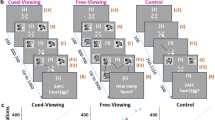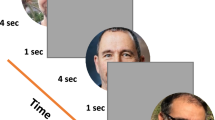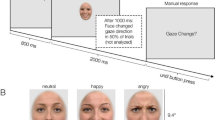Summary
The influence of visual fixation position and stimulus size on the scalp-recorded “vertex positive peak” (VPP) evoked by images of faces was studied in three subjects. Responses were recorded, in turn, for line-drawn, frontal-view faces of approximately 8, 4, 2, and 1 deg length, fixated at the centre (bridge of the nose), and at points 1,2, 3, and 4 deg to the left and right, and above and below, centre. The results showed that central fixation produced VPPs of similar, maximal amplitude for all face sizes. By comparison, “on-face” eccentric viewing yielded attenuated and delayed responses, and the degree of response attenuation as a function of eccentricity was directly related to the face size, with similar amplitude responses being evoked for corresponding fixation locations on each face. Very small or no VPPs were recorded for most “off-face” fixations. Similar results were observed for profile faces, except that the maximal VPP was recorded for fixations near the eyes and not in the centre of the head, and almost identical VPPs were evoked by a centrally fixated face presented with and without an adjacent face or object. These response properties, which correspond to the subjective perception of the facial stimuli, suggest that the VPP reflects brain mechanisms optimized to respond to single, fixated faces, irrespective both of facial image size and of the presence of neighbouring figures.
Similar content being viewed by others
References
Bruce C, Desimone R, Gross CG (1981) Visual properties of neurons in a polysensory area in superior temporal sulcus of the macaque. J Neurophysiol 46: 369–384
Cook M (1978) Eye movements during recognition of faces. In: Gruneberg MM, Morris PE, Sykes RN (eds) Practical aspects of memory. Academic Press, New York, pp 286–292
Desimone R (1991) Face-selective cells in the temporal cortex of monkeys. J Cogn Neurosci 3: 1–8
Desimone R, Albright TD, Gross CG, Bruce C (1984) Stimulusselective properties of inferior temporal neurons in the macaque. J Neurosci 4: 2051–2062
Deubel H, Findlay J, Jacobs AM, Brogan D (1988) Saccadic eyemovements to targets defined by structure differences. In: Luer G, Lass U, Shallo-Hoffman J (eds) Eye movement research: physiological and psychological aspects. Hogrefe, Göttingen, pp 107–145
Findlay JM (1982) Global visual processing for saccadic eye movements. Vision Res 22: 1033–1045
Groner R, Walder F, Groner M (1984) Looking at faces: local and global aspects of scanpaths. In: Gale AG, Johnson F (eds) Theoretical and applied aspects of eye movement research. Elsevie/North-Holland, Amsterdam, pp 523–533
Gross CG, Rocha-Miranda CE, Bender DB (1972) Visual properties of neurons in inferotemporal cortex of the macaque. J Neurophysiol 35: 96–111.
Grundy JH (1982) Human structure and shape. Smith C (ed) Noble Books, Chilbolton, Hants, UK
Harries MH, Perrett DI (1991) Visual processing of faces in temporal cortex: physiological evidence for a modular organization and possible anatomical correlates. J Cognitive Sci 3: 9–24
Humphreys GW, Bruce V (1989) Visual cognition. Erlbaum, Hillsdale, N.J.
Jeffreys DA (1977) The physiological significance of pattern visual evoked potentials. In: Desmedt J (ed) Visual evoked potentials in man: new developments. Clarendon Press, Oxford, pp 134–167
Jeffreys DA (1980) Contour-specific potentials evoked by saccadic image displacement. J Physiol (Lond) 298:24P
Jeffreys DA (1989a) A face-responsive potential recorded from the human scalp. Exp Brain Res 78: 193–202
Jeffreys DA (1989b) Evoked potential studies of contour processing in human visual cortex. In: Kulikowski JJ, Dickinson CM, Murray IJ (eds) Contour and colour. Pergamon, London, pp 529–545
Jeffreys DA, Axford JG (1972) Source locations of pattern-specific components of human visual evoked potentials. I. Component of striate cortical origin. II. Component of extrastriate cortical origin. Exp Brain Res 16: 1–40
Jeffreys DA, Tukmachi ESA (1992) The vertex-positive scalp potential evoked by faces and by objects. Exp Brain Res 91: 340–350
Julesz B (1984) A brief outline of the texton theory of human vision. Trends Neurosci 7: 41–45
Kaufman L, Richards W (1969) Spontaneous fixation tendencies for visual forms. Percept Psychophys 5: 85–88
Lu ST, Hamalainen MS, Hari R, Ilmoniemi RJ, Lounasmaa OV, Sams M, Vilkman V (1991) Seeing faces activates three separate areas outside the occipital visual cortex in man. Neuroscience 43: 287–290
Luria SM, Strauss MS (1978) Comparison of eye movements over faces in photographic positives and negatives. Perception 7: 349–358
Mishkin M, Ungerleider LG, Macko K (1983) Object vision and spatial vision: two cortical pathways. Trends Neurosci 6: 414–417
Neisser U (1967) Cognitive psychology. Appleton-Century-Crofts, New York
Noton D, Stark L (1971) Scanpaths in saccadic eye movements during pattern perception. Science 171: 308–311
Perrett DI, Rolls ET, Caan W (1982) Visual neurones responsive to faces in the monkey temporal cortex. Exp Brain Res 47: 329–342
Perrett DI, Smith PAJ, Potter DD, Mistlin AJ, Head AS, Milner AD, Jeeves MA (1984) Neurones responsive to faces in the temporal cortex: studies of functional organization, sensitivity to identity and relation to perception. Hum Neurobiol 3: 197–208
Perrett DI, Mistlin AJ, Chitty AJ (1987) Visual neurones responsive to faces. Trends Neurosci 10: 358–364
Perrett DI, Mistlin AJ (1990) Perception of facial characteristics by monkeys. In: Stebbins WC, Berkley MA (eds) Comparative perception, vol II: complex signals. Wiley, New York, pp 187–215
Richards W, Kaufman L (1969) “Center-of-gravity” tendencies for fixations and flow patterns. Percept Psychophys 5: 81–84
Rolls ET, Baylis CC (1986) Size and contrast have only small effects on the responses to faces of neurons in the cortex of the superior temporal sulcus of the monkey. Exp Brain Res 65: 38–48
Schneider GE (1969) Two visual systems. Science 163: 895–902
Sergent J (1987) Methodological constraints on neuropsychological studies of face perception in normals. In: Bruyer R (ed) Neuropsychology of face perception and facial expression. Erlbaum, Hillsdale, N. J., pp 91–124
Sergent J, Hellige JB (1986) Role of input factors in visual-field asymmetries. Brain Cogn 5: 174–199
Tanaka K, Saito H-A, Fukada Y, Moriya M (1991) Coding visual images of objects in the inferotemporal cortex of the macaque monkey. J. Neurophysiol 66: 170–189
Trevarthen CB (1968) Two mechanisms of vision in primates. Psychol Forsch 31: 299–337
Van Essen DC, Maunsell JHR (1983) Hierarchical organization and functional streams in the visual cortex. Trends Neurosci 6: 370–375
Walker-Smith GJ, Gale AG, Findlay JM (1977) Eye movement strategies involved in face perception. Perception 6: 313–326
Yarbus AL (1967) Eye movements and vision. Plenum, New York
Author information
Authors and Affiliations
Rights and permissions
About this article
Cite this article
Jeffreys, D.A., Tukmachi, E.S.A. & Rockley, G. Evoked potential evidence for human brain mechanisms that respond to single, fixated faces. Exp Brain Res 91, 351–362 (1992). https://doi.org/10.1007/BF00231669
Received:
Accepted:
Issue Date:
DOI: https://doi.org/10.1007/BF00231669




